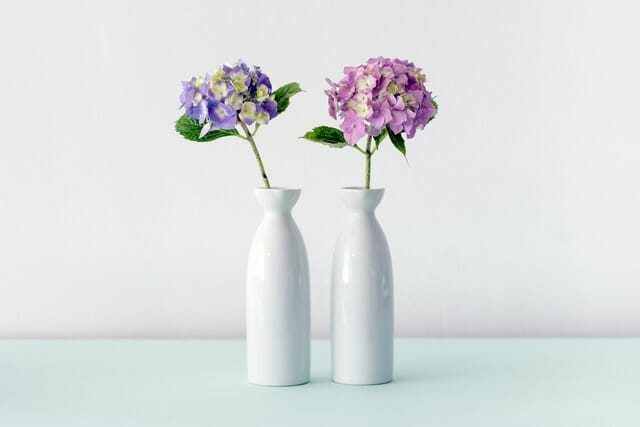Last Updated on January 28, 2022 by Grow with Bovees
Hydrangeas are a very easy plant to grow and one of the most rewarding because of their long flowering period and their suitability for growing in containers and borders.
In addition, with the correct treatment, they can be enjoyed inside the home as cut hydrangeas in vases.
Follow our cut hydrangea care advice to find out how to keep hydrangeas alive for the longest time!
How To Keep Cut Hydrangeas Fresh And Stop Wilting In The Vase
In order to get the absolute best out of your fresh hydrangeas, we have put together a foolproof procedure checklist for you;
1. Best Time To Cut Hydrangeas

- The time of day when you pick fresh cut hydrangeas plays a major role in the length of life of your hydrangeas in a vase or arrangement.
- Early morning is by far the optimal time, after they have cooled down overnight and taken in plenty of water and carbohydrates so that their stems are full of sap and their leaves have taken in additional moisture from the morning dew.
- As the day begins to warm up, all plants start to lose their rigidity to some degree as their cells release water through transpiration.
2. Selecting Which Hydrangeas To Cut Is the Next Step
Each bloom is made up of a mass of individual flowers.
Depending on the species, some have the same sized individual flowers all over the flower-head while others have tiny flowers in the central area surrounded by larger bracts on the outer edges which make the whole head attractive.
It is important at this stage to only select heads where most of the florets, including the tiny ones in the center, are open, as otherwise, the flowerhead is likely to fade very quickly.
You can determine this by whether you can see the stamens in the middle of each floret or not. If the stamens are clearly visible, then you know the flower is open.
3. How You Cut A Hydrangea Flower Is Also Very Important

You will need a bucket or other large vessel full of water and a sharp knife or gardening secateurs/clippers which are designed to make a clean cut causing damage to a minimal number of cells at the point where the hydrangea is cut. I find that these Fiskars pruners are very good quality.
General-purpose scissors and blunt knives are likely to crush the cells, preventing them from absorbing water for transportation up the stem.
The stems need to be as long as possible so that there is as much stem as possible to support the flower with a good supply of water and nutrients before being used in a hydrangea vase.
Select a suitable site on the hydrangea flower to cut and cut the hydrangea at a 45 degree angle.
This provides maximum available surface area for water take up – the pointed end preventing the cut area from pressing against the bottom once the hydrangea is in the vase.
As soon as the stem has been cut it should be put straight into the bucket of water up to its neck before the cut starts to seal over.
Knowing how to cut the stems of hydrangea flowers is crucial when wanting to know how to keep cut hydrangeas from wilting.
4. The Boiling Water Trick
Once you have finished cutting your hydrangea flowers, take them inside and put a kettle of water on to boil.

Making sure that you use a suitable vessel that won’t melt, place the bottom 3-4cm of the stems in boiling water at a slight angle so that the steam doesn’t damage the petals and leave to stand in the water for 30 seconds.
Using hot water sounds a little drastic but it certainly seems to help stop a cut hydrangea from wilting.
After the boiling water trick, you can put the cut hydrangea flowers back in the bucket of water up to their necks or at least 20 cm, for a couple of hours or preferably overnight before you start arranging the hydrangeas in a vase.
5. Conditioning and Preservatives
While the cut hydrangeas are soaking up more moisture you can prepare the water for use in the final arrangement.
Using a preservative substance of some sort to condition cut flowers and thereby increase their longevity, is now widely recognized as a very effective practice when investigating how to keep hydrangeas alive, hence the little sachets that generally come with a purchased bunch of flowers.
You can either concoct your own homemade treatment or use one of the many treatments available over the counter mixed with tap water, just be careful to mix it to the recommended ratio.
If you have some to hand, a teaspoon of alum spice (usually used for keeping vegetables crisp when pickling) works wonders.
Using room temperature water for most cut flowers (excluding flowers from bulbs) is another standard procedure recommended by professional florists and horticulturalists when asked, for example, how to keep hydrangeas fresh for a wedding, because warm water molecules travel faster than cold ones, so the cells can absorb them and transport them more quickly up through the stems to the flower head.
6. Final Trimming of Hydrangea Stems
When you are ready to start arranging the flowers it is a good idea to first remove any leaves on the hydrangea stem that will sit below the waterline so that they don’t stagnate in the water and breed bacteria.
After all your hard work you don’t want a random leaf to be the cause of your hydrangea wilting in the vase.
Then trim your hydrangea stems to the desired length.
Ok, so now you’re ready to create a beautiful arrangement with your beautiful, carefully prepared hydrangea blooms and know pretty much all there is to know about how to keep hydrangeas fresh every time.
7. Alum Is Said To Make Hydrangeas Last Longer
Many gardeners have noticed that something as simple as sprinkling Alum around a hydrangea can make it bloom longer in the warmer months. But what is Alum, and why does it have this effect?
Alum is a naturally occurring mineral.
It is also a common ingredient in household cleaning products, where it is used to remove stains from clothing and prevent odor, and is also found in foot deodorant. (I have no idea why.) Using Alum to prevent Hydrangeas from wilting will not only help you make them last longer, it will also keep your garden looking clean and tidy.
How To Care for Cut Hydrangeas In Your Arrangement
Once your arrangement is complete there is a simple method of maintenance that you should adopt in order to be confident you will be keeping your cut hydrangeas fresh for as long as possible, enabling you to enjoy your blooms for the longest possible period;
- Your hydrangea blooms will benefit from being in a cool environment and out of the path of direct sunlight or drafts, so bear those points in mind when you decide where to position your arrangement.
- Make sure you change the water every couple of days or so for fresh water including your preservative of choice, especially if you see your blooms start to droop.
- If they do start to droop, then you can cut off an inch of stem and use the boiling water trick again. In fact, you can repeat it as often as you need to until it stops working!
How Long Do Cut Hydrangeas Last?
If you follow all of the above tips then you shouldn’t have a problem keeping hydrangeas alive as long as is truly possible and they will continue to delight you for at least a couple of weeks!
From Where Do Hydrangeas Originate?
The hydrangeas grown today are in fact hybrids derived from species originally native to Asia and The Americas.
Proof of their popularity, both for use as cutting hydrangeas in hydrangea vases and also as ornamental garden shrubs, lies in the fact that hundreds of different cultivars have been created in recent years.
What Are the Different Varieties and Colors of Hydrangea?
In current times the selection of Hydrangeas available on the market can be split into five main different types; Bigleaf Hydrangeas/Hydrangea Macrophylla (these include the most popular hydrangea cutting flowers; Mophead & Lacecap), Panicle Hydrangeas, Smooth Hydrangeas, Oakleaf Hydrangeas, Mountain Hydrangeas, and Climbing Hydrangeas.
The colors within each variety can vary from Green/White, through all shades of pink, purple, and blue and even, more recently, cultivators have started producing some beautiful red shades which are stunning hydrangeas as cut flowers.
While Oak leaf, Climbing & Smooth Hydrangeas are all only available in white or shades of green and white, the species which come in the pink/blue shades can even be modified to some degree by the use of different hydrangea fertilizers.
This is because the pH value of the soil affects the color of the hydrangea flowers; acid (below pH6) soils turn hydrangea flowers blue, whereas alkaline soils (above pH 7.0) produce more pink hydrangeas, or in the case of red varieties, gives them a more intense red color.
Now that you know how to take care of hydrangeas in a vase, you’ll have no more wilting hydrangeas, just long-lasting arrangements of beauty.
Enjoy!! And thank you for sharing…
References;
https://www.thoughtco.com/what-is-alum-608508
https://study.com/articles/Become_a_Horticulturalist_Education_and_Career_Roadmap.html

